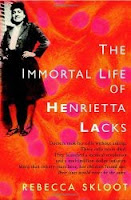Thanks to Molly, a friend who bought the book and loaned it to me, I'm happy to say I read it recently -- and happier still to give it a five-star recommendation, based on the number of pages I dog-eared along the way.
It's an absorbing read -- part science, part biography, part social and cultural history -- that covers several decades, beginning in the 1950s when "colored" folks were treated in a separate wing of Johns Hopkins University Hospital and continuing up to the present. Author Rebecca Skloot explains the scientific practices and procedures then in place for harvesting cells, along with the ethical considerations and commercial applications that have evolved since then. She also sketches compelling portraits of Henrietta Lacks and her family -- none of whom knew their wife/mother had been the subject of this research until 20 years after her death, and all of whom struggle to get health care themselves.
"I've tried to imagine how she'd feel knowing that her cells went up in the first space missions to see what would happen to human cells in zero gravity, or that they helped with some of the most important advances in medicine: the polio vaccine, chemotherapy, cloning, gene mapping, in vitro fertilization," Skloot writes in the prologue. "I'm pretty sure that she -- like most of us-- would be shocked to hear that there are trillions more of her cells growing in laboratories now than there ever were in her body.I suspect that only those who write professionally -- or aspire to -- can fully appreciate what went into the making of this book, which landed on The New York Times Bestseller list this spring and has brought much acclaim to its author, a former Portland resident who now teaches at the University of Memphis.
"There's no way of knowing exactly how many of Henrietta's cells are alive today. One scientist estimates that if you could pile all HeLa cells ever grown onto a scale, they'd weigh more than 50 million metric tons -- an inconceivable number, given that an individual cells weighs almost nothing. Another scientist calculated that if you could lay all HeLa cells ever grown end-to-end, they'd wrap around the Earth at least three times, spanning more than 350 million feet. In her prime, Henrietta herself stood only a bit over five feet tall."
Skloot first learned about HeLa cells in 1988 -- 37 years after Lacks' death -- at age 16 when she was in a community college biology class. Later, as she was working her way through graduate school studying writing, she began researching Henrietta's story. She read scientific journals and historical documents. She interviewed scientists, lab assistants and several members of Henrietta's extended family, even spending time in Clover, Virginia, where the Lacks clan traces its roots to an old, segregated town where their slave ancestors worked on tobacco farms. The reporting and writing consumed an astounding 10 years.
This is Rebecca Skloot's first book, and it's immensely satisfying. In an interview with The Oregonian's Jeff Baker, she and her father, author Floyd Skloot, talked about the writing process. Read about it here -- "The story behind the story" -- and then do yourself a favor and go get the book. Quick, before it becomes a movie produced by Oprah!

No comments:
Post a Comment